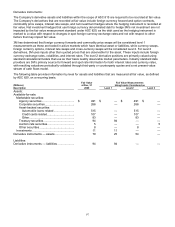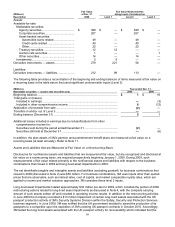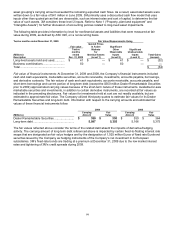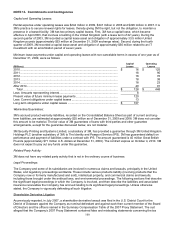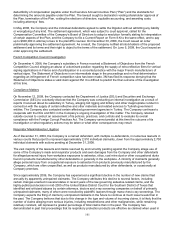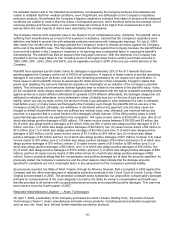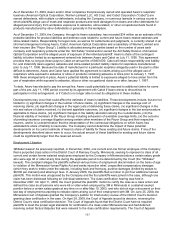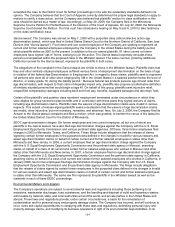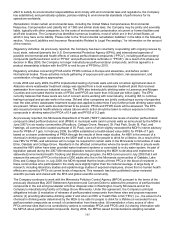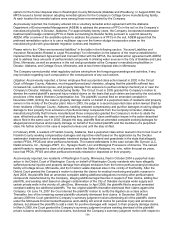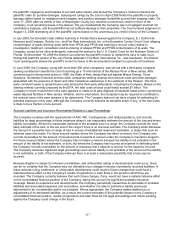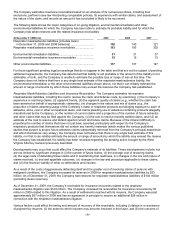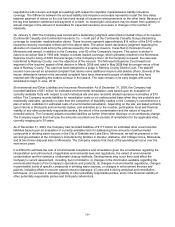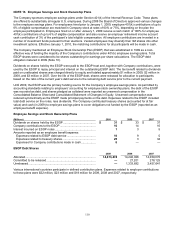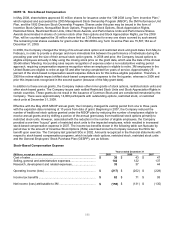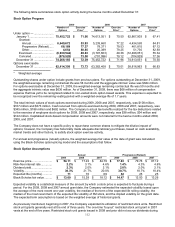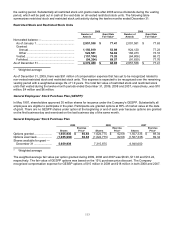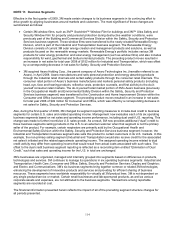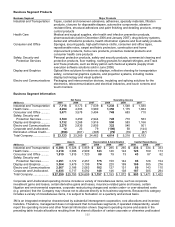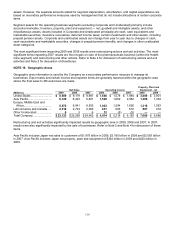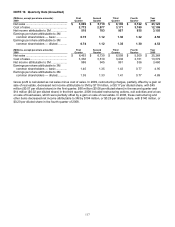3M 2009 Annual Report Download - page 113
Download and view the complete annual report
Please find page 113 of the 2009 3M annual report below. You can navigate through the pages in the report by either clicking on the pages listed below, or by using the keyword search tool below to find specific information within the annual report.
107
the plaintiffs’ negligence and trespass to soil and water claims, and denied the Company’s motion to dismiss the
plaintiffs’ claim for punitive damages. Subsequent rulings by the Court in April 2009 limited the plaintiffs to property
damage claims based on negligence and trespass, and punitive damages if plaintiffs proved their trespass claim. On
June 17, 2009, after six weeks of trial, a Washington County jury returned a unanimous verdict in favor of the
Company on all remaining issues in the lawsuit. The jury decided that the Company was not negligent and had not
committed a trespass, and that plaintiffs had not suffered damage to their properties. The Court entered judgment on
August 13, 2009 dismissing all of the plaintiffs’ claims based on the unanimous jury verdict in favor of the Company.
In July 2009, the Emerald Coast Utilities Authority in Florida filed a lawsuit against the Company, E.I. DuPont de
Nemours and Company, Solutia, Inc., and Fire Ram International, Inc. in the Escambia County Circuit Court alleging
contamination of public drinking water wells from PFOA and PFOS and seeking to recover costs related to
investigation, treatment, remediation and monitoring of alleged PFOA and PFOS contamination of its wells. The
Company, joined by the other defendants, removed the lawsuit to the U. S. District Court for the Northern District of
Florida. On November 19, 2009 the District Court denied the plaintiff’s motion to remand the case to state court,
finding that plaintiff’s joinder of the only Florida defendant, Fire Ram International, Inc., was fraudulent. The District
Court subsequently denied the plaintiff’s motion for leave to file an amended complaint on grounds of timeliness.
In June 2009, the Company, along with more than 250 other companies, was served with a third-party complaint
seeking contribution towards the cost of cleaning up a 17-mile stretch of the Passaic River in New Jersey. After
commencing an enforcement action in 1990, the State of New Jersey filed suit against Maxus Energy, Tierra
Solutions, Occidental Chemical and two other companies seeking cleanup and removal costs and other damages
associated with the presence of dioxin and other hazardous substances in the sediment of the Passaic. The third-
party complaint seeks to spread those costs among the third-party defendants, including the Company. Based on the
cleanup remedy currently proposed by the EPA, the total costs at issue could easily exceed $1 billion. The
Company’s recent involvement in the case appears to relate to its past disposal of industrial waste at two commercial
waste disposal facilities in New Jersey. Whether, and to what extent, the Company may be required to contribute to
the costs at issue in the case remains to be determined. The Company does not yet have a basis for estimating its
potential exposure in this case, although the Company currently believes its allocable share, if any, of the total costs
is likely to be a fraction of one percent.
Accrued Liabilities and Insurance Receivables Related to Legal Proceedings
The Company complies with the requirements of ASC 450, Contingencies, and related guidance, and records
liabilities for legal proceedings in those instances where it can reasonably estimate the amount of the loss and where
liability is probable. Where the reasonable estimate of the probable loss is a range, the Company records the most
likely estimate of the loss, or the low end of the range if there is no one best estimate. The Company either discloses
the amount of a possible loss or range of loss in excess of established reserves if estimable, or states that such an
estimate cannot be made. For those insured matters where the Company has taken a reserve, the Company also
records receivables for the amount of insurance that it expects to recover under the Company’s insurance program.
For those insured matters where the Company has not taken a reserve because the liability is not probable or the
amount of the liability is not estimable, or both, but where the Company has incurred an expense in defending itself,
the Company records receivables for the amount of insurance that it expects to recover for the expense incurred.
The Company discloses significant legal proceedings even where liability is not probable or the amount of the liability
is not estimable, or both, if the Company believes there is at least a reasonable possibility that a loss may be
incurred.
Because litigation is subject to inherent uncertainties, and unfavorable rulings or developments could occur, there
can be no certainty that the Company may not ultimately incur charges in excess of presently recorded liabilities. A
future adverse ruling, settlement, or unfavorable development could result in future charges that could have a
material adverse effect on the Company’s results of operations or cash flows in the period in which they are
recorded. The Company currently believes that such future charges, if any, would not have a material adverse effect
on the consolidated financial position of the Company, taking into account its significant available insurance
coverage. Based on experience and developments, the Company periodically reexamines its estimates of probable
liabilities and associated expenses and receivables, and whether it is able to estimate a liability previously
determined to be not estimable and/or not probable. Where appropriate, the Company makes additions to or
adjustments of its estimated liabilities. As a result, the current estimates of the potential impact on the Company’s
consolidated financial position, results of operations and cash flows for the legal proceedings and claims pending
against the Company could change in the future.


